MAP OF INDIA DURING DIFFERENT TIMES:-
 |
| CONTROL OF INDIA BY THE BRITISH EAST INDIA COMPANY |
Map of India Before Independence:-

Map of India Today:-

World Heritage Monuments of India
MAP(go to following link)
The Cultural Sites
|
Agra Fort, Agra (1983)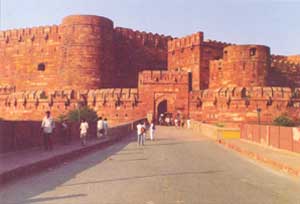 Agra Fort represents the first major building project of Akbar, with remains of only a few buildings built by him which now survive. Built on the site of an earlier castle in AD 1565-1575, the fort, apart from other important units, contains Jahangiri Mahal, Khass Mahal, Diwan-i-Khass, Diwan-i-Am, Machchhi Bhawan and Moti Masjid. Many extant buildings were erected by Shah Jahan (AD 1630-1655). Of its four gates, the most impressive is the Delhi Gate on the west. Agra Fort represents the first major building project of Akbar, with remains of only a few buildings built by him which now survive. Built on the site of an earlier castle in AD 1565-1575, the fort, apart from other important units, contains Jahangiri Mahal, Khass Mahal, Diwan-i-Khass, Diwan-i-Am, Machchhi Bhawan and Moti Masjid. Many extant buildings were erected by Shah Jahan (AD 1630-1655). Of its four gates, the most impressive is the Delhi Gate on the west. |
Ajanta Caves (1983)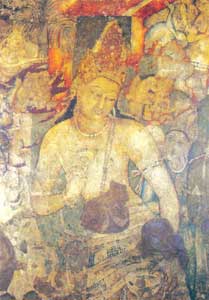 The world famous Ajanta Caves including the unfinished ones are thirty in number, of which five (9, 10, 19, 26 and 29) are chaitya-grihas and the rest are viharas (monasteries). The world famous Ajanta Caves including the unfinished ones are thirty in number, of which five (9, 10, 19, 26 and 29) are chaitya-grihas and the rest are viharas (monasteries). |
Ellora Caves (1983)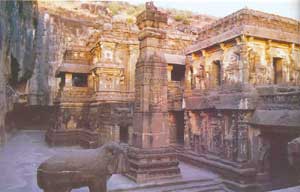 The magnificent group of rock-cut shrines of Ellora, representing three different faiths, Buddhist, Brahmanical and Jaina were excavated during the period from fifth to the thirteenth century AD. The magnificent group of rock-cut shrines of Ellora, representing three different faiths, Buddhist, Brahmanical and Jaina were excavated during the period from fifth to the thirteenth century AD. |
Taj Mahal, Agra (1983)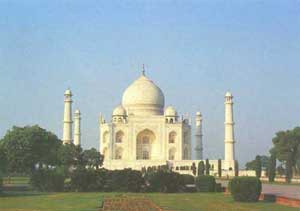 Taj on the right bank of River Yamuna, about 1.5km from the Agra fort, was built to enshrine the remains of Arjumand Banu Begam entitled Mumtaj Mahal, the queen of the Mughal emperor Shah Jahan. lts construction commenced in AD 1631 and completed seventeen years later at an enormous cost and labour. d. Taj on the right bank of River Yamuna, about 1.5km from the Agra fort, was built to enshrine the remains of Arjumand Banu Begam entitled Mumtaj Mahal, the queen of the Mughal emperor Shah Jahan. lts construction commenced in AD 1631 and completed seventeen years later at an enormous cost and labour. d. |
Mahabalipuram Group of Monuments (1984)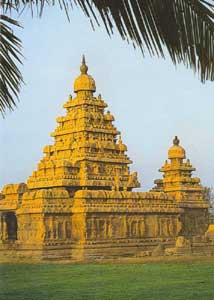 Mahabalipuram or Mamallapuram, the city of Mamalla, is named after the title of great Pallava ruler Narasimhavarman-I (AD 630-668). It was a sea-port during the time of Periplus (first century AD) and Ptolemy (AD 140) and many Indian colonists sailed to South-East Asia through this port town. Mahabalipuram or Mamallapuram, the city of Mamalla, is named after the title of great Pallava ruler Narasimhavarman-I (AD 630-668). It was a sea-port during the time of Periplus (first century AD) and Ptolemy (AD 140) and many Indian colonists sailed to South-East Asia through this port town. |
Sun Temple, Konark (1984)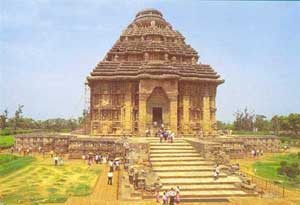 Konark is the Kainapara of the Periplus (first century AD) - an important port of the Orissan coast. The most notable marvel is the stately Sun Temple, built in c. AD 1250, during the reign of the Eastern Ganga King Narasimhadeva-I (AD 1238-1264), to enshrine an image of Sun (Arka), the patron deity of the place. Konark is the Kainapara of the Periplus (first century AD) - an important port of the Orissan coast. The most notable marvel is the stately Sun Temple, built in c. AD 1250, during the reign of the Eastern Ganga King Narasimhadeva-I (AD 1238-1264), to enshrine an image of Sun (Arka), the patron deity of the place. |
Group of Monuments at Hampi (1986)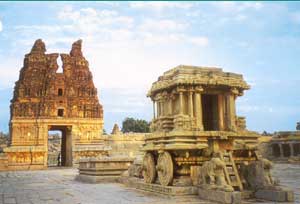 Hampi, on the southern bank of the Tungabhadra, once formed the seat of the mighty Vijayanagara empire. The contemporary chroniclers who came from far off countries like Arabia, Italy, Portugal and Russia visited the empire and have left graphic and glowing accounts of the city. Hampi, on the southern bank of the Tungabhadra, once formed the seat of the mighty Vijayanagara empire. The contemporary chroniclers who came from far off countries like Arabia, Italy, Portugal and Russia visited the empire and have left graphic and glowing accounts of the city. |
Fatehpur Sikri, Agra (1986)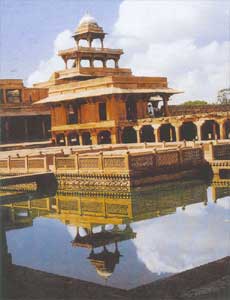 In honour of saint Shaikh Salim Chishti, the Mughal emperor Akbar, the great, founded a magnificent city on Sikri ridge. In 1571 he ordered the construction of buildings for his own use and asked the noblemen to built houses for themselves. Within a year, most of the work was finished and within the next few years, a well planned city with administrative, residential and religious buildings came into existence. In honour of saint Shaikh Salim Chishti, the Mughal emperor Akbar, the great, founded a magnificent city on Sikri ridge. In 1571 he ordered the construction of buildings for his own use and asked the noblemen to built houses for themselves. Within a year, most of the work was finished and within the next few years, a well planned city with administrative, residential and religious buildings came into existence. |
Khajuraho Group of Monuments (1986)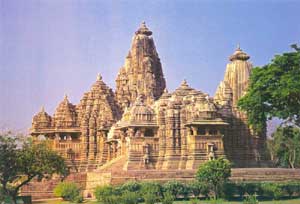 Khajuraho, the ancient Kharjjuravahaka, was the principal seat of authority of the Chandella rulers who adorned it with numerous tanks, scores of lofty temples of sculptural grace and architectural splendour. The local tradition lists eighty-five temples but now only twenty-five are standing examples in various stages of preservation. But for Chausath-Yogini, Brahma and Mahadeva which are of granite, all the other temples are of fine grained sandstone, buff, pink or pale yellow in colour. The Lakshmana temple dedicated to Vishnu built byYasovarman (AD 954), is an ornate and evolved example. Khajuraho, the ancient Kharjjuravahaka, was the principal seat of authority of the Chandella rulers who adorned it with numerous tanks, scores of lofty temples of sculptural grace and architectural splendour. The local tradition lists eighty-five temples but now only twenty-five are standing examples in various stages of preservation. But for Chausath-Yogini, Brahma and Mahadeva which are of granite, all the other temples are of fine grained sandstone, buff, pink or pale yellow in colour. The Lakshmana temple dedicated to Vishnu built byYasovarman (AD 954), is an ornate and evolved example. |
Elephanta Caves (1987)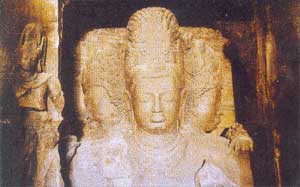 Elephanta anciently known as Gharapuri, the island capital of Konkan Mauryas, is celebrated for its colossal image of Mahesamurti with three heads each representing a different form. Elephanta anciently known as Gharapuri, the island capital of Konkan Mauryas, is celebrated for its colossal image of Mahesamurti with three heads each representing a different form.
In fact, there are seven caves out of which the most important is the Mahesamurti cave. The main body of the cave, excluding the porticos on the three open sides and the back isle is 27 metres square and is supported by rows of six columns each. The gigantic figures of dvarapalas or doorkeepers here are very impressive.
|
Great Living Chola Temples (1987, 2004)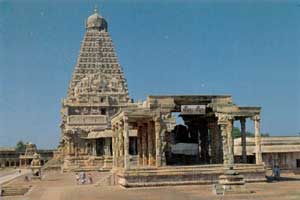 The celebrated Saiva temple, appropriately called Brihadisvara and Dakshinameru, is the grandest creation of the Chola emperor Rajaraja (AD 985-1012) at Thanjavur. It was inaugurated by the king himself in his 19th regnal year and named it after himself as Rajesvara Peruvudaiyar. Architecturally, it is the most ambitious structural temple built of granite. The temple is within a spacious inner prakara of 240.90 m long (east-west) and 122m broad (north-south), with a gopura at the east and three other ordinary toranaentrances one at each lateral sides and the third at rear. The celebrated Saiva temple, appropriately called Brihadisvara and Dakshinameru, is the grandest creation of the Chola emperor Rajaraja (AD 985-1012) at Thanjavur. It was inaugurated by the king himself in his 19th regnal year and named it after himself as Rajesvara Peruvudaiyar. Architecturally, it is the most ambitious structural temple built of granite. The temple is within a spacious inner prakara of 240.90 m long (east-west) and 122m broad (north-south), with a gopura at the east and three other ordinary toranaentrances one at each lateral sides and the third at rear. |
Group of Monuments at Pattadakal (1987)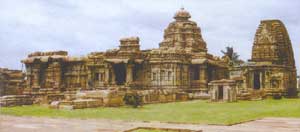 Pattadakal is not only popular for Chalukyan architecture but it is also a holy place for royal coronation, Pattadakisuvolal. Temples constructed here mark the blending of the RekhaNagara-Prasada and the Dravida Vimana styles of temple building. Pattadakal is not only popular for Chalukyan architecture but it is also a holy place for royal coronation, Pattadakisuvolal. Temples constructed here mark the blending of the RekhaNagara-Prasada and the Dravida Vimana styles of temple building.
The oldest temple at Pattadakal is Sangamesvara built by Vijayaditya Satyasraya (AD 697733). It is a simple but massive structure.
|
Buddhist Monuments at Sanchi (1989)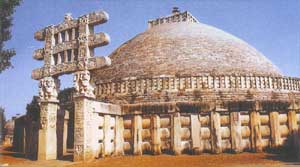 Imposing Stupa-1 with four gateways and railings made Sanchi a world famous Buddhist site. The original stupa of the Asokan times was enlarged and faced with stones.lt is decorated with balustrades, staircases and an umbrella on top. Besides this, other stupas, monolithic Asokan pillar, many other temples, monasteries and sculptures are found scattered at Sanchi and its adjoining hills from the Mauryan period to the twelfth century AD. Imposing Stupa-1 with four gateways and railings made Sanchi a world famous Buddhist site. The original stupa of the Asokan times was enlarged and faced with stones.lt is decorated with balustrades, staircases and an umbrella on top. Besides this, other stupas, monolithic Asokan pillar, many other temples, monasteries and sculptures are found scattered at Sanchi and its adjoining hills from the Mauryan period to the twelfth century AD. |
Humayun's Tomb; New Delhi (1993)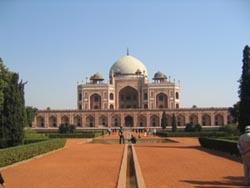 The first substantial example of a garden tomb on charbagh pattern with high arches and double dome was erected by Humayun's queen Hamida Banu Begam (Haji Begam) in AD 1569 at a cost of 15 lakh rupees (1.5 million). The first substantial example of a garden tomb on charbagh pattern with high arches and double dome was erected by Humayun's queen Hamida Banu Begam (Haji Begam) in AD 1569 at a cost of 15 lakh rupees (1.5 million). |
Qutb Complex, New Delhi (1993)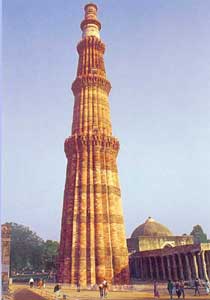 Qutb-Minar in red and buff sandstone is the highest tower in India. It has a diameter of 14.32m at the base and about 2.75m on the top with a height of 72.5m. Qutb-Minar in red and buff sandstone is the highest tower in India. It has a diameter of 14.32m at the base and about 2.75m on the top with a height of 72.5m.
Qutbu'd-Din Aibak laid the foundation of Minar in AD 1199 for the use of the mu'azzin (crier) to give calls for prayer and raised the first storey, to which were added three more storeys by his successor and son-in-law, Shamsu'd-Din IItutmish (AD 1211-1236). All the storeys are surrounded by a projected balcony encircling the minar and supported by stone brackets, which are decorated with honey-comb design, more conspicuously in the first storey.
Numerous inscriptions in Arabic and Nagari characters in different places of the minar reveal the history of Qutb. According to the inscriptions on its surface it was repaired by Firuz Shah Tughlaq (AD 1351-1388) and Sikandar Lodi (AD 1489-1517).
|
Mahabodhi Temple,Bodhgaya (2002)
The Mahabodhi Temple Complex is one of the four holy sites related to the life of the Lord Buddha, and particularly to the attainment of Enlightenment. The first temple was built by Emperor Asoka in the 3rd century B.C., and the present temple dates from the 5th or 6th centuries. It is one of the earliest Buddhist temples built entirely in brick, still standing in India, from the late Gupta period
|
Prehistoric Rock Shelters of Bhimbetka (2003)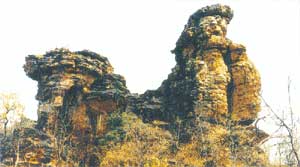 The Rock Shelters of Bhimbetka are in the foothills of the Vindhyan Mountains on the southern edge of the Central Indian plateau. The Rock Shelters of Bhimbetka are in the foothills of the Vindhyan Mountains on the southern edge of the Central Indian plateau. |
Champaner-Pavagadh Archaeological Park(2004)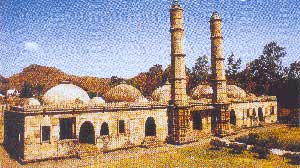 The impressive archaeological remains, located about fifty kms from Baroda (Gujarat) are at the foot of the Pavagadh hill. It was a prosperous medieval capital which ranked with other medieval capitals viz., Fatehpur Sikri and Vijayanagara. The impressive archaeological remains, located about fifty kms from Baroda (Gujarat) are at the foot of the Pavagadh hill. It was a prosperous medieval capital which ranked with other medieval capitals viz., Fatehpur Sikri and Vijayanagara. |
Red Fort Complex, Delhi (2007)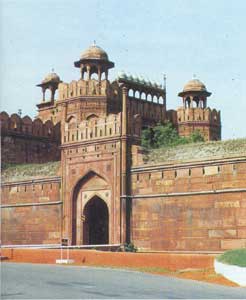 The Red Fort Complex was built as the palace fort of Shahjahanabad - the new capital of the 5th Mughal Emperor of India, Shahjahan (1628-58). It gets its name from its massive enclosing walls of red sandstone. It is adjacent to an older fort, the Salimgarh, built by Islam Shah Sur in 1546, with which it forms the Red Fort Complex. The Red Fort Complex was built as the palace fort of Shahjahanabad - the new capital of the 5th Mughal Emperor of India, Shahjahan (1628-58). It gets its name from its massive enclosing walls of red sandstone. It is adjacent to an older fort, the Salimgarh, built by Islam Shah Sur in 1546, with which it forms the Red Fort Complex. |
No comments:
Post a Comment